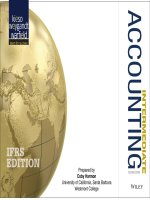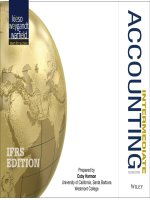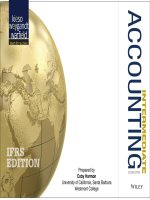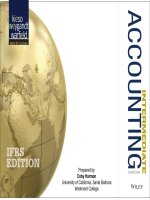Lecture Intermediate accounting (IFRS/e) - Chapter 8: Inventories: Measurement
Bạn đang xem bản rút gọn của tài liệu. Xem và tải ngay bản đầy đủ của tài liệu tại đây (797.88 KB, 57 trang )
Chapter 8
INVENTORIES:
MEASUREMENT
© 2013 The McGraw-Hill Companies, Inc.
Recording and Measuring Inventory
Types of Inventory
Merchandise
Inventory
Goods acquired for
resale
8-2
Manufacturing
Inventory
•Raw Materials
•work-in-progress
•Finished Goods
Manufacturing Inventories
Raw
Materials
Work in
Progress
$XX
Finished
Goods
$XX
Direct
Labor
Manufacturing
Overhead
8-3
Cost of Goods Sold
$XX
Raw materials purchased
Direct labor incurred
Manufacturing overhead incurred
Raw materials used
Direct labor applied
Manufacturing overhead applied
Work in progress transferred to finished goods
Finished goods sold
Inventory Systems
Two accounting systems are used to record
transactions involving inventory:
8-4
Perpetual
Perpetual Inventory
Inventory
System
System
Periodic
Periodic Inventory
Inventory
System
System
The
The inventory
inventory
account
account is
is
continuously
continuously
updated
updated as
as
purchases
purchases and
and
sales
sales are
are made.
made.
The
The inventory
inventory
account
account is
is adjusted
adjusted
at
at the
the end
end of
of aa
reporting
reporting cycle.
cycle.
Perpetual Inventory System
Lothridge Wholesale Beverage Company (LWBC) begins
2013 with $120,000 in inventory. During the period it
purchases on account $600,000 of merchandise for resale
to customers.
2013
Inventory
Accounts payable
600,000
600,000
Purchase of merchandise inventory on account
Returns of inventory are credited to the inventory
account.
Discounts on inventory purchases can be recorded
using the gross or net method.
8-5
Perpetual Inventory System
During 2013, LWBC sold, on account, inventory with a retail
price of $820,000 and a cost basis of $540,000, to customers.
2013
Inventory
Accounts payable
600,000
600,000
Purchase of merchandise inventory on account.
2013
Accounts receivable
Sales revenue
820,000
820,000
Record sales on account.
Cost of goods sold
Inventory
Record cost of goods sold.
8-6
540,000
540,000
Periodic Inventory System
The periodic inventory system is not designed to track
either the quantity or cost of merchandise inventory. Cost
of goods sold is calculated, using the schedule below, after
the physical inventory count at the end of the period.
Beginning Inventory
+ Net Purchases
Cost of Goods Available for Sale
- Ending Inventory
= Cost of Goods Sold
8-7
Periodic Inventory System
Lothridge Wholesale Beverage Company (LWBC) begins
2013 with $120,000 in inventory. During the period it
purchases on account $600,000 of merchandise for resale
to customers.
2013
Purchases
Accounts payable
Purchase of merchandise inventory on account
8-8
600,000
600,000
Periodic Inventory System
During 2013, LWBC sold, on account, inventory with a retail
price of $820,000 to customers, and a cost basis of $540,000.
2013
Accounts receivable
Sales revenue
820,000
820,000
Record sales on account.
No entry is made to record Cost of Goods Sold. A physical count
of Ending Inventory shows a balance of $180,000. Let’s
calculate Cost of Goods Sold at the end of 2013.
8-9
Periodic Inventory System
Calculation of Cost of Goods Sold
Beginning inventory
Plus: Purchases
Cost of goods available for sale
Less: Ending inventory
Cost of goods sold
$
120,000
600,000
720,000
(180,000)
$ 540,000
We need the following adjusting entry to record cost of good sold.
December 31, 2013
Cost of goods sold
Inventory (ending)
Inventory (beginning)
Purchases
540,000
180,000
120,000
600,000
To adjust inventory, close purchases, and record cost of goods sold.
8 - 10
Comparison of Inventory Systems
8 - 11
What is Included in Inventory?
General Rule
All goods owned by the company on the inventory
date, regardless of their location.
Goods
Goodsin
inTransit
Transit
Depends
Dependson
onFOB
FOB
shipping
shippingterms.
terms.
8 - 12
Goods
Goods on
on
Consignment
Consignment
Expenditures Included in Inventory
Invoice
InvoicePrice
Price
Purchase
Purchase
Returns
Returnsand
and
Allowances
Allowances
+
Freight-in
Freight-inon
on
Purchases
Purchases
8 - 13
Purchase
Purchase
Discounts
Discounts
Purchase Returns
On November 8, 2013, LWBC returns merchandise that had a cost
to LWBC of $2,000, and a cost basis to the seller of 1,600.
Periodic Inventory Method
November 8, 2013
Accounts payable
2,000
Purchase returns and allowances
2,000
Perpetual Inventory Method
Accounts payable
Inventory
2,000
Returns
Returns of inventory are credited to the Purchase Returns
and Allowances account when using the periodic
inventory method.
The returns are credited to Inventory using the perpetual
inventory method.
8 - 14
2,000
Purchase Discounts
Gross Method
October 5, 2013
Purchases
Accounts payable
20,000
20,000
October 14, 2013
Accounts payable
14,000
Purchase discounts
Cash
November 4, 2013
Accounts payable
Cash
Discount terms are
2/10, n/30.
$14,000
x 0.02
$ 280
8 - 15
Net Method
280
13,720
6,000
6,000
Partial payment not
made within the
discount period
Purchases
Accounts payable
19,600
Accounts payable
Cash
13,720
Accounts payable
Interest expense
Cash
5,880
120
19,600
13,720
6,000
$20,000
x 0.02
$ 400
-120
$ 280
Inventory Cost Flow Assumptions
•• Specific
Specific identification
identification
•• Average
Average cost
cost
•• First-in,
First-in, first-out
first-out (FIFO)
(FIFO)
•• Last-in,
Last-in, first-out
first-out (LIFO)
(LIFO)
8 - 16
Perpetual Average Cost
Picture This, LLC, uses a standard frame size for
all pictures to hold down product costs. The
following schedule shows the frame inventory for
Picture This, LLC, for September.
The physical inventory count at September 30
shows 1,400 frames in ending inventory.
Use the perpetual average cost method to
determine:
(1) Ending inventory cost
(2) Cost of goods sold
8 - 17
Perpetual Average Cost
Picture This, LLC
Frame Inventory
Date
Beg. Inventory
9/3
9/15
9/21
9/29
Units
1,200
900
550
600
800
Goods Available for Sale
Ending Inventory
Goods Sold
4,050
(1,400)
2,650
8 - 18
$/Unit
$ 22.00
24.00
25.00
27.00
28.00
Total
$ 26,400.00
21,600.00
13,750.00
16,200.00
22,400.00
$ 100,350.00
-
Perpetual Average Cost
Date
Purchased
Beg. Inv. 1,200 x $ 22.00 =
9/3
900 x
24.00 =
9/15
550 x
25.00 =
9/15
Average Cost
26,400 $
22.00
21,600
22.86
13,750
23.30
Sold
1000 x
23.30 =
$61,750 ÷ (1,200 + 900 + 550) = $23.30 rounded
8 - 19
23,300.00
Balance
$ 26,400.00
48,000.00
61,750.00
38,450.00
Perpetual Average Cost
Date
Purchased
Beg. Inv. 1,200 x $ 22.00 =
9-3
900 x
24.00 =
9-15
550 x
25.00 =
9-15 2,650
9-21
600
27.00
9-22
Average Cost
26,400 $
22.00
21,600
22.86
13,750
23.30
Sold
1000 x
16,200
23.30 =
24.29
700
24.29
Balance
$ 26,400.00
48,000.00
61,750.00
23,300.00
38,450.00
54,650.00
17,003.00
37,647.00
[(1,650
[(1,650 ×× $23.30)
$23.30) ++ (600
(600 ×× $27)]
$27)] ÷÷ 2,250
2,250 == $24.29
$24.29 rounded
rounded
8 - 20
Perpetual Average Cost
Date
Purchased
Beg. Inv. 1,200 x $ 22.00 =
9-3
900 x
24.00 =
9-15
550 x
25.00 =
9-15 2,650
9-21
600 x
27.00 =
9-22
9-29
800 x
28.00 =
9-30
Average Cost
26,400 $
22.00
21,600
22.86
13,750
23.30
16,200
22,400
1,550 × $ 24.29 = $
800 ×
28.00 =
2,350
$
Weighted Average Cost $
Sold
1000 x
23.30 =
700 x
24.29 =
950 x
25.55 =
24.29
25.55
Balance
$ 26,400.00
48,000.00
61,750.00
23,300.00
38,450.00
54,650.00
17,003.00
37,647.00
60,047.00
24,272.50
35,774.50
37,650
22,400
60,050
25.55
Ending inventory = 1,400 units × $25.55 = $35,770
Rounding error
8 - 21
Perpetual Average Cost
Picture This, LLC
Frame Inventory
Date
Beg. Inventory
9/3
9/15
9/21
9/29
Goods Available for Sale
Ending Inventory
Cost of Goods Sold
8 - 22
Units
1,200
900
550
600
800
4,050
1,400
2,650
$/Unit
$ 22.00
24.00
25.00
27.00
28.00
Total
$ 26,400.00
21,600.00
13,750.00
16,200.00
22,400.00
$ 100,350.00
35,774.50
$ 64,575.50
Weighted-Average Periodic System
Let’s use the same information to assign costs to
ending inventory and cost of goods sold using the
periodic system.
Ending Inventory
(1,400 units)
Available
Available
for
forSale
Sale
(4,050
(4,050units)
units)
Goods Sold
(2,650)
$100,350 ÷ 4,050 = $24.7778 weightedaverage per unit cost
8 - 23
Weighted-Average Periodic System
Picture This, LLC
Frame Inventory
Date
Beg. Inventory
9/3
9/15
9/21
9/29
Goods Available for Sale
Ending Inventory
Cost of Goods Sold
8 - 24
Units
1,200
900
550
600
800
4,050
(1,400)
2,650
$/Unit
$ 22.00
24.00
25.00
27.00
28.00
$ 24.7778
$ 24.7778
Total
$ 26,400.00
21,600.00
13,750.00
16,200.00
22,400.00
$ 100,350.00
(34,688.92)
$ 65,661.08
First-In, First-Out (FIFO)
The FIFO
method
assumes that
items are sold
in the
chronological
order of their
acquisition.
8 - 25
•• The
The cost
cost of
of the
the oldest
oldest
inventory
inventory items
items are
are
charged
charged to
to COGS
COGS
when
when goods
goods are
are sold.
sold.
•• The
The cost
cost of
of the
the
newest
newest inventory
inventory
items
items remain
remain in
in
ending
ending inventory.
inventory.









